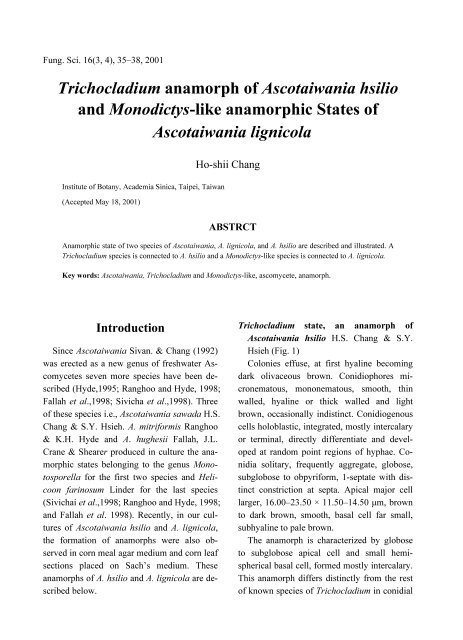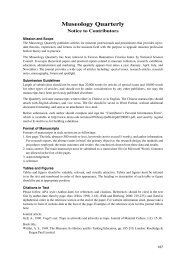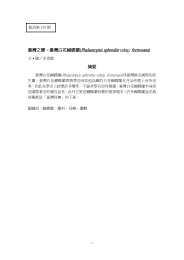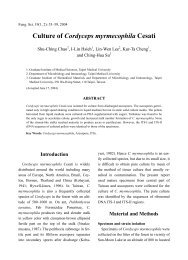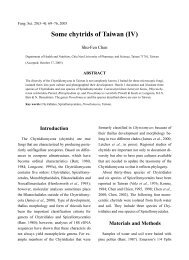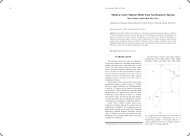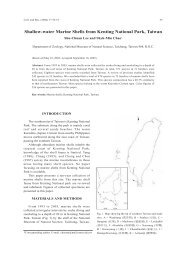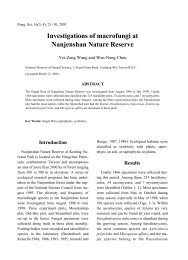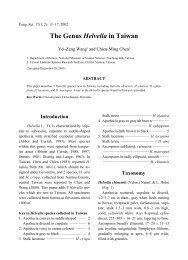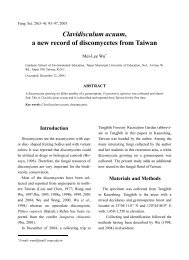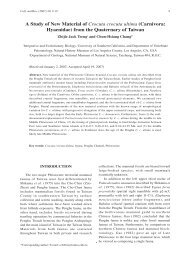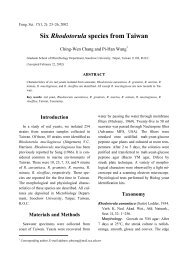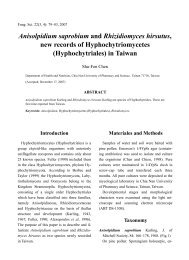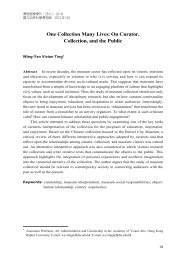Trichocladium anamorph of Ascotaiwania hsilio and Monodictys-like ...
Trichocladium anamorph of Ascotaiwania hsilio and Monodictys-like ...
Trichocladium anamorph of Ascotaiwania hsilio and Monodictys-like ...
Create successful ePaper yourself
Turn your PDF publications into a flip-book with our unique Google optimized e-Paper software.
Fung. Sci. 16(3, 4), 35–38, 2001<br />
<strong>Trichocladium</strong> <strong>anamorph</strong> <strong>of</strong> <strong>Ascotaiwania</strong> <strong>hsilio</strong><br />
<strong>and</strong> <strong>Monodictys</strong>-<strong>like</strong> <strong>anamorph</strong>ic States <strong>of</strong><br />
<strong>Ascotaiwania</strong> lignicola<br />
Institute <strong>of</strong> Botany, Academia Sinica, Taipei, Taiwan<br />
(Accepted May 18, 2001)<br />
Ho-shii Chang<br />
ABSTRCT<br />
Anamorphic state <strong>of</strong> two species <strong>of</strong> <strong>Ascotaiwania</strong>, A. lignicola, <strong>and</strong> A. <strong>hsilio</strong> are described <strong>and</strong> illustrated. A<br />
<strong>Trichocladium</strong> species is connected to A. <strong>hsilio</strong> <strong>and</strong> a <strong>Monodictys</strong>-<strong>like</strong> species is connected to A. lignicola.<br />
Key words: <strong>Ascotaiwania</strong>, <strong>Trichocladium</strong> <strong>and</strong> <strong>Monodictys</strong>-<strong>like</strong>, ascomycete, <strong>anamorph</strong>.<br />
Introduction<br />
Since <strong>Ascotaiwania</strong> Sivan. & Chang (1992)<br />
was erected as a new genus <strong>of</strong> freshwater Ascomycetes<br />
seven more species have been described<br />
(Hyde,1995; Ranghoo <strong>and</strong> Hyde, 1998;<br />
Fallah et al.,1998; Sivicha et al.,1998). Three<br />
<strong>of</strong> these species i.e., <strong>Ascotaiwania</strong> sawada H.S.<br />
Chang & S.Y. Hsieh. A. mitriformis Ranghoo<br />
& K.H. Hyde <strong>and</strong> A. hughesii Fallah, J.L.<br />
Crane & Shearer produced in culture the <strong>anamorph</strong>ic<br />
states belonging to the genus Monotosporella<br />
for the first two species <strong>and</strong> Helicoon<br />
farinosum Linder for the last species<br />
(Sivichai et al.,1998; Ranghoo <strong>and</strong> Hyde, 1998;<br />
<strong>and</strong> Fallah et al. 1998). Recently, in our cultures<br />
<strong>of</strong> <strong>Ascotaiwania</strong> <strong>hsilio</strong> <strong>and</strong> A. lignicola,<br />
the formation <strong>of</strong> <strong>anamorph</strong>s were also observed<br />
in corn meal agar medium <strong>and</strong> corn leaf<br />
sections placed on Sach’s medium. These<br />
<strong>anamorph</strong>s <strong>of</strong> A. <strong>hsilio</strong> <strong>and</strong> A. lignicola are described<br />
below.<br />
<strong>Trichocladium</strong> state, an <strong>anamorph</strong> <strong>of</strong><br />
<strong>Ascotaiwania</strong> <strong>hsilio</strong> H.S. Chang & S.Y.<br />
Hsieh (Fig. 1)<br />
Colonies effuse, at first hyaline becoming<br />
dark olivaceous brown. Conidiophores micronematous,<br />
mononematous, smooth, thin<br />
walled, hyaline or thick walled <strong>and</strong> light<br />
brown, occasionally indistinct. Conidiogenous<br />
cells holoblastic, integrated, mostly intercalary<br />
or terminal, directly differentiate <strong>and</strong> developed<br />
at r<strong>and</strong>om point regions <strong>of</strong> hyphae. Conidia<br />
solitary, frequently aggregate, globose,<br />
subglobose to obpyriform, 1-septate with distinct<br />
constriction at septa. Apical major cell<br />
larger, 16.00–23.50 × 11.50–14.50 µm, brown<br />
to dark brown, smooth, basal cell far small,<br />
subhyaline to pale brown.<br />
The <strong>anamorph</strong> is characterized by globose<br />
to subglobose apical cell <strong>and</strong> small hemispherical<br />
basal cell, formed mostly intercalary.<br />
This <strong>anamorph</strong> differs distinctly from the rest<br />
<strong>of</strong> known species <strong>of</strong> <strong>Trichocladium</strong> in conidial
36 Fung. Sci. 16(3, 4), 2001<br />
morphology, though closely related to T. alopallonelum<br />
(Meyer <strong>and</strong> Moore) Kohlm. &<br />
Volkm.-Kohlm. <strong>and</strong> T. nypae K.D. Hyde &<br />
Goh in shape <strong>of</strong> conidia but conidia <strong>of</strong> this<br />
<strong>anamorph</strong> with only one septum <strong>and</strong> hemispherical<br />
basal cell. This <strong>Trichocladium</strong> species<br />
is also differs from T. uniseptatum Berk.&<br />
broome, the <strong>anamorph</strong> <strong>of</strong> Ascolacicola aquatic<br />
Ranghoo et K.D. Hyde, in its globose conidia<br />
<strong>and</strong> without distinct conidiogenous cells.<br />
Anamorphic state <strong>of</strong> this fungus is also present<br />
along with teleomorph, in natural substrate on<br />
decayed tree twigs collected from stream in<br />
Wulai, Taipei county.<br />
<strong>Monodictys</strong>-<strong>like</strong> <strong>anamorph</strong> <strong>of</strong> <strong>Ascotaiwania</strong><br />
lignicola (Fig. 2)<br />
Colonies effuse, conidiophores micronema-<br />
tous to semi-macronematous, mononematous,<br />
flexuous, brown, smooth, swollen. Conidiogenous<br />
cells monoblastic, integrated, determinate,<br />
cylindrical. Conidia ellipsoidal or subspherical,<br />
multicellular, mostly aggregate, constricted at<br />
septa, dark reddish brown to almost dark,<br />
smooth, 29.50–42.75 × 17.25–44.50 µm.<br />
This <strong>Monodictys</strong>-<strong>like</strong> <strong>anamorph</strong> seems<br />
closely to M. putredinis (Wallr.) Hughes in<br />
conidial morphology. In one culture teleomorph,<br />
the perithecia <strong>of</strong> A. lignicola with mature<br />
ascospores, were also observed formed<br />
along with <strong>anamorph</strong> on autoclaved corn leaf<br />
section placed on Sach’s medium.<br />
Although conidia <strong>of</strong> <strong>Trichocladium</strong> <strong>and</strong><br />
<strong>Monodictys</strong> are different in their morphology,<br />
they are similar in conidium ontogeny. <strong>Trichocladium</strong><br />
<strong>and</strong> <strong>Monodictys</strong> are frequently en-<br />
Fig. 1. Anamorph <strong>of</strong> <strong>Ascotaiwania</strong> <strong>hsilio</strong>, a <strong>Trichocladium</strong> fungus: A <strong>and</strong> B, conidia <strong>and</strong> conidium formation. Bar scale:<br />
20 µm.
<strong>Ascotaiwania</strong> <strong>hsilio</strong> <strong>and</strong> A. lignicola 37<br />
Fig. 2. Anamorph <strong>of</strong> <strong>Ascotaiwania</strong> lignicola, a <strong>Monodictys</strong>-<strong>like</strong> fungus: A, B, C, <strong>and</strong> D conidia <strong>and</strong> conidiophores, <strong>and</strong><br />
distribution <strong>of</strong> conidia on substrate. Bar scale: 20 µm.<br />
countered in the habitats where <strong>Ascotaiwania</strong><br />
occur. Likewise, Monotosporella <strong>and</strong> Helicoon<br />
were also frequently encountered in similar<br />
habitats. Apparently genus <strong>Ascotaiwania</strong> is<br />
associated with various types <strong>of</strong> <strong>anamorph</strong>s.<br />
References<br />
Chang, H.S., S.Y. Hsieh, E.B.G. Jones, S.T.<br />
Read, <strong>and</strong> S.T. Moss. 1998. New freshwater<br />
species <strong>of</strong> <strong>Ascotaiwania</strong> <strong>and</strong> Savoryella<br />
from Taiwan. Mycol. Res. 102: 709–718.<br />
Fallah, P.M., J.L. Crane, <strong>and</strong> C.A. Shearer.<br />
1998. Freshwater ascomycetes: two new<br />
species <strong>of</strong> <strong>Ascotaiwania</strong> from North Amer-<br />
ica. Canadian Jour. Botany 77: 87–92.<br />
Hyde K.D. 1995. Fungi from palms. ΧΙΙ. A<br />
new species <strong>of</strong> <strong>Ascotaiwania</strong> Sydowia 47:<br />
213–216.<br />
Ranghoo, V.M. <strong>and</strong> K.D. Hyde. 1998. Ascomycetes<br />
from freshwater habitats: Ascolacicola<br />
aquatica gen. et sp. Nov. <strong>and</strong> a new<br />
species <strong>of</strong> <strong>Ascotaiwania</strong> from wood submerged<br />
in a reservoir in Hong Kong.<br />
Mycologia 90: 1055–1062.<br />
Sivanesan, A. <strong>and</strong> H.S. Chang. 1992 <strong>Ascotaiwania</strong>,<br />
a new amphisphaeriaceous ascomycete<br />
genus on wood from Taiwan. Mycol.<br />
Res. 96: 481–484.<br />
Sivicha, S.N. Hywel-Jones <strong>and</strong> E.B.G. Jones.
38 Fung. Sci. 16(3, 4), 2001<br />
1998. Lignicolous freshwater ascomycota<br />
from Thail<strong>and</strong>: 1. <strong>Ascotaiwania</strong> sawada <strong>and</strong><br />
its <strong>anamorph</strong> state Monotosporella. Mycoscience<br />
38: 307–311.<br />
兩種 <strong>Ascotaiwania</strong> 屬菌的不完全世代<br />
中央研究院植物研究所,臺北,臺灣<br />
張 和 喜<br />
摘 要<br />
本文紀錄 <strong>Ascotaiwania</strong> <strong>hsilio</strong> 和 A. lignicola 的不完全世代,分別為屬於 <strong>Trichocladium</strong> 和 <strong>Monodictys</strong><br />
屬菌。<br />
關鍵詞:水棲子囊菌、無性世代。


